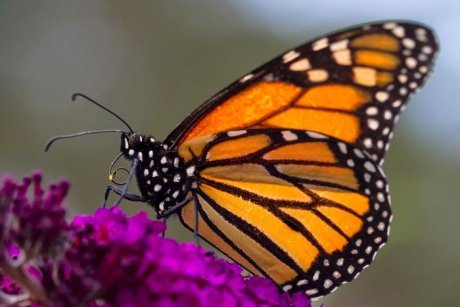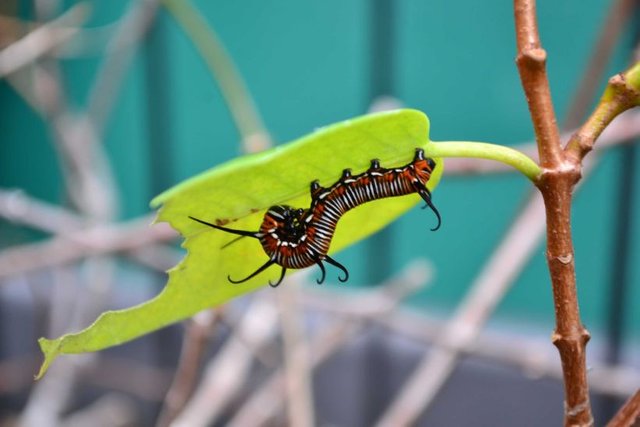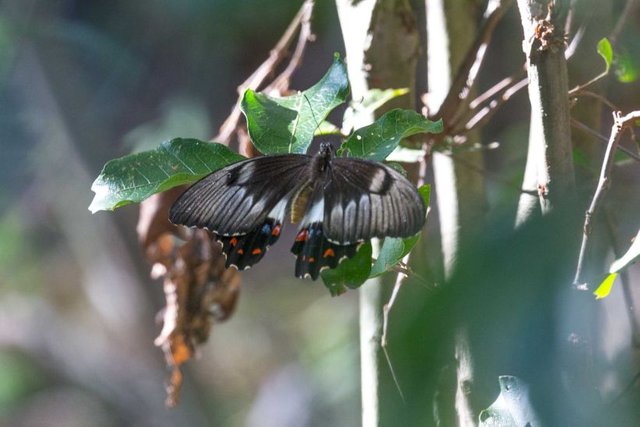The secret to attracting butterflies to your garden

Amongst the growing metropolis of shiny, black apartment buildings in Brisbane's West End, a tiny caterpillar clings to a stem, keeping watch over a small garden.
It is in this unassuming garden that Helen Schwencke has spent several decades studying and raising native butterflies.
"This little, tiny patch of urban jungle has raised at least fifty species," she says.
Ms Schwencke, co-author of Create More Butterflies: a guide to 48 butterflies and their host-plants for south-east Queensland and northern New South Wales, sees raising butterflies as an introduction to those new to interacting with nature.
"You can actually start interacting with nature in the smallest of spaces.
"You can have a balcony with a native fig or a weeping fig on it and you'll get common crow [butterflies].
"A pretty butterfly is a really lovely way to ... start getting your eye in."
The only good leaf is a chewed leaf

Many butterflies are species-specific in their host plant selection, meaning they will only lay their eggs on one or two species of plant, where their caterpillars will then feed, grow and form their protective chrysalis while they metamorphose into adult butterflies.
Ms Schwencke has a list of 10 plants that can attract 32 butterfly species in south-east Queensland but she says there are two important factors to consider when choosing a plant to attract butterflies.
The first is that native host plants will support many more insects than non-native plants as well as having a closer relationship with other species, which will help support the rest of the ecosystem.
The second is that it is more useful to provide egg and caterpillar host plants than nectar plants for adults.
"There's a big difference between increasing the population of butterflies and feeding passing adults, so growing the host plants feeds the life cycle so you end up with more butterflies," she says.
"Eye candy plants... you can tell they're not being eaten so they're not providing any sort of ecosystem services
"The only good leaf is a chewed leaf."
Attracting butterflies can repel pests

Ms Schwencke says it is extremely important to create more patches of habitat to sustain biodiversity in an increasingly urban environment.
"I'm an island in a biological desert," she says, gesturing around her thickly vegetated, suburban garden and explaining that you don't need a huge amount of space to make a difference.
"You can actually start doing this kind of interaction and increasing species diversity and having all sorts of ecological flow-on effects, even if you don't want to, in the smallest of spaces.
"If you start with a fig on a balcony soon enough you'll end up with a chrysalis tree. They will strip it, but figs are completely adapted to that so it won't be a problem at all."
She also reminds us that native caterpillars aren't a threat to most herb and vegetable gardens.
"Your butterfly caterpillars won't eat your vegetables, except for the cabbage white [butterfly], and they're introduced."
In fact, by encouraging more native butterflies and their habitat, you are more likely to attract predators that can help keep populations under control.
Hi! I am a robot. I just upvoted you! I found similar content that readers might be interested in:
http://www.abc.net.au/news/2018-02-13/how-to-attract-butterflies-to-your-garden/9422772
Congratulations @samirpaul! You received a personal award!
Click here to view your Board
Congratulations @samirpaul! You received a personal award!
You can view your badges on your Steem Board and compare to others on the Steem Ranking
Vote for @Steemitboard as a witness to get one more award and increased upvotes!